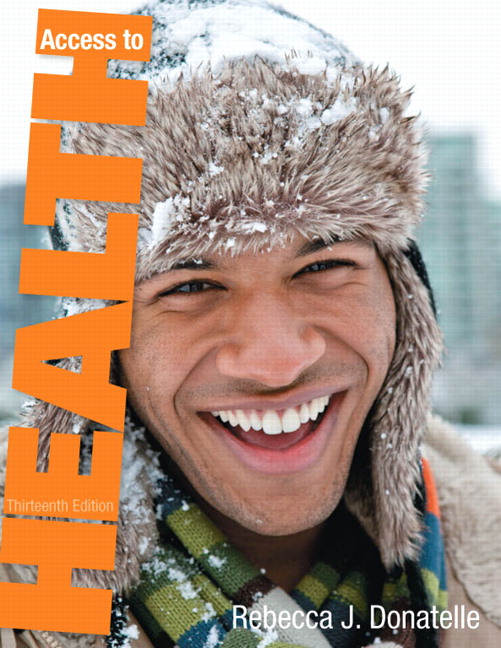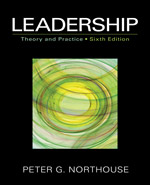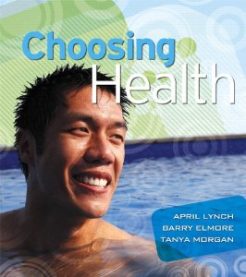Description
Access to Health, 13e (Donatelle)
Chapter 1 Accessing Your Health
1) Which of the following individual choices has a major effect on both current health and projected life expectancy?
A) Genetic tendency toward obesity.
B) Pollution
C) Level of education
D) Smoking
Answer: D
Diff: 2 Page Ref: 3
Skill: Analyzing
2) The medical model of health would most likely focus on which of the following?
A) Controlling air and water pollution
B) Lifestyle interventions to prevent chronic diseases
C) Treating bacterial infections with antibiotics
D) Serving marginalized populations
Answer: C
Diff: 2 Page Ref: 6
Skill: Understanding
3) The number of years a person is anticipated to live based on conditions at the time of birth is
A) life expectancy.
B) population control.
C) mortality.
D) morbidity.
Answer: A
Diff: 2 Page Ref: 4
Skill: Understanding
4) Which of the following were cited by college students in a national survey as major impediments to performing well academically?
A) Pressure from parents and family members
B) Stress, anxiety, and sleep difficulties
C) Repeated strep infections
D) Carrying a too-heavy course load
Answer: B
Diff: 1 Page Ref: 3
Skill: Understanding/Analyzing
5) What is the leading cause of death in the United States across all age groups?
A) Heart disease
B) Cancer
C) Cerebrovascular disease
D) Unintentional injuries
Answer: A
Diff: 1 Page Ref: 4
Skill: Understanding
6) Which of the following describes the rate of deaths within a certain population?
A) Prevalence
B) Life expectancy
C) Mortality
D) Morbidity
Answer: C
Diff: 2 Page Ref: 4
Skill: Understanding
7) Heart disease, cancer, and diabetes are examples of
A) chronic disease.
B) hereditary disease.
C) communicable disease.
D) acute disease.
Answer: A
Diff: 1 Page Ref: 4
Skill: Remembering
8) Since the early 20th century, the life expectancy of Americans has
A) increased by more than 10 years.
B) increased by more than 20 years.
C) increased by more than 30 years.
D) increased by more than 40 years.
Answer: C
Diff: 2 Page Ref: 4
Skill: Understanding
9) Healthy life expectancy refers to the number of years a person can expect to live
A) while covered by Medicare.
B) without chronic pain, disability, or significant illness.
C) without pain or short-term or long-term disability.
D) without cancer or diabetes.
Answer: B
Diff: 2 Page Ref: 5
Skill: Remembering
10) Life expectancy 100 years ago was largely determined by
A) medical history.
B) lifestyle choices.
C) susceptibility to chronic disease.
D) susceptibility to infectious disease.
Answer: D
Diff: 1 Page Ref: 4
Skill: Understanding/Evaluating
11) The term health is often interchangeable with the term
A) adaptability.
B) flexibility.
C) wellness.
D) pain-free.
Answer: C
Diff: 2 Page Ref: 6
Skill: Remembering
12) Jerome eats healthy foods, exercises regularly, gets eight hours of sleep each night, and rarely becomes ill. His ability to ward off illness is related to which dimension of health?
A) Social
B) Intellectual
C) Physical
D) Emotional
Answer: C
Diff: 2 Page Ref: 8
Skill: Applying
13) Jasmine has many friends, is respected by her coworkers, and maintains a great relationship with her boyfriend. Her ability to interact with others exemplifies which dimension of health?
A) Social
B) Intellectual
C) Emotional
D) Physical
Answer: A
Diff: 2 Page Ref: 8
Skill: Applying
14) Rashid volunteers weekly to help pick up trash in his neighborhood. This action contributes to improving which dimension of his health?
A) Intellectual
B) Social
C) Environmental
D) Spiritual
Answer: C
Diff: 2 Page Ref: 9
Skill: Applying
15) Which of the following best describes emotional health?
A) Ability to be self-sufficient
B) Ability to solve problems
C) Ability to express or control feelings
D) Ability to adapt to various social situations
Answer: C
Diff: 2 Page Ref: 9
Skill: Understanding
16) An example of intellectual health is
A) having a sense of meaning and purpose in your life.
B) successfully interacting with others.
C) having low self-efficacy.
D) having a healthy curiosity about life in general.
Answer: D
Diff: 2 Page Ref: 9
Skill: Understanding
17) Which of the following best describes spiritual health?
A) Possessing and expressing a purpose in life
B) Expressing emotions
C) Having satisfying relationships
D) Being able to reason and think objectively
Answer: A
Diff: 1 Page Ref: 9
Skill: Understanding
18) A multidimensional concept of health that includes elements of physical, mental, emotional, and social function is
A) physical and emotional health.
B) holistic health care.
C) health-related quality of life.
D) healthy life expectancy.
Answer: C
Diff: 2 Page Ref: 5
Skill: Understanding
19) The first step in modifying your health behavior to achieve overall wellness is to
A) review your medical records and schedule a physical examination by a doctor.
B) become aware of individual behaviors that contribute to or detract from your health.
C) complete a detailed behavior change contract.
D) find a reliable support person or support group.
Answer: B
Diff: 2 Page Ref: 10
Skill: Understanding
20) Holistic wellness involves
A) integrating mind, body, and spiritual components.
B) taking nutritional supplements daily.
C) combining exercise with some form of meditation.
D) consuming organic foods and being treated by a naturopathic doctor.
Answer: A
Diff: 2 Page Ref: 9
Skill: Applying
21) The range of factors that influence a person’s health status are known as
A) ethnic or cultural traditions.
B) determinants of health.
C) age-related conditions.
D) genetic influences on health.
Answer: B
Diff: 2 Page Ref: 9
Skill: Understanding
22) Determinants of health include
A) personal, social, economic, and environmental factors.
B) physical, intellectual, spiritual, and cultural factors.
C) nutritional, social, financial, and environmental factors.
D) genetic and lifestyle factors.
Answer: A
Diff: 2 Page Ref: 9
Skill: Understanding
23) Which of the following methods is an example of successful lifestyle change?
A) Making a New Year’s resolution to stop smoking again after failing in the past
B) Creating a demanding workout plan in hopes of someday losing weight
C) Beginning a daily walking program and gradually increasing your time and distance
D) Stopping smoking “cold turkey”
Answer: C
Diff: 2 Page Ref: 16
Skill: Applying
24) Jackson made a goal to quit smoking by the end of the year through a lot of hard work and willpower. When he achieved this goal, he bought himself a new car. This is an example of
A) repeated enabling.
B) social reinforcement.
C) positive reinforcement.
D) negative reinforcement.
Answer: C
Diff: 2 Page Ref: 23
Skill: Understanding/Applying
25) Moving from thinking about starting an exercise program to joining a club, working with a trainer to set goals, and showing up for workouts is an example of which model of behavior change?
A) Health belief model
B) Social cognitive model
C) Transtheoretical model
D) Contemplation model
Answer: C
Diff: 3 Page Ref: 16
Skill: Understanding
26) Tasks that are necessary for normal functioning in society are known as
A) activities of daily living.
B) high-level tasks.
C) low-level tasks.
D) vocational activities.
Answer: A
Diff: 2 Page Ref: 8
Skill: Remembering
27) Mark is a junior in college and plans to move to his own apartment before his senior year. He hopes to quit drinking, get more sleep, and spend more time exercising and studying instead of spending so much of his free time on Facebook. The best plan for Mark to succeed is for him to
A) make a chart with an algorithm for coordinating all the changes.
B) try to change all of his bad behaviors at once.
C) select the most important behavior to change and take things one step at a time.
D) worry about changing behaviors later because he’ll have plenty of time to change after he finishes college.
Answer: C
Diff: 2 Page Ref: 17-18
Skill: Applying
28) Which of the following factors would be considered a nonmodifiable determinant of health?
A) Sexual behavior
B) Sleep habits
C) Geographic location
D) Genetics
Answer: D
Diff: 2 Page Ref: 10
Skill: Understanding
29) Which of the following is an example of a belief?
A) Disliking the smell of cigarette smoke
B) Thinking that smoking is unhealthy and causes cancer
C) Being happy no one is smoking near you
D) Understanding that smoking has become more prevalent among teenagers
Answer: B
Diff: 2 Page Ref: 14
Skill: Understanding
30) Marissa has tried to quit smoking several times but ultimately failed because she lost motivation and didn’t believe she could succeed. Which of the following may have contributed to her failure?
A) She has a strong internal locus of control.
B) She has high self-efficacy.
C) She has a strong external locus of control.
D) She has a strong, positive support group.
Answer: C
Diff: 2 Page Ref: 19-20
Skill: Analyzing
31) Because both of John’s parents smoke, John has a higher-than-average chance of being a smoker. This is an example of
A) a reinforcing factor.
B) a predisposing factor.
C) a confirming factor.
D) an enabling factor.
Answer: B
Diff: 3 Page Ref: 17
Skill: Understanding
32) Which of the following best describes an enabling factor?
A) Living near a hiking trail when you want to begin a walking program
B) Nagging your parents because they smoke
C) Encouraging your spouse to go to the fitness club with you
D) Having friends who don’t exercise, but you want to start a fitness program
Answer: A
Diff: 2 Page Ref: 17
Skill: Understanding
33) Poor housing, lack of funds for adequate food and clothes, and insecure employment are which type of factors that negatively affect human health?
A) Biological
B) Economic
C) Behavioral
D) Genetic
Answer: B
Diff: 2 Page Ref: 11
Skill: Understanding
34) Carrie grew up in an active family. Now that Carrie lives on her own, her family continues to check in to see if she is making time for exercise. They praise her for joining a fitness club and keeping to a workout schedule. This is an example of
A) a predisposing factor.
B) a confirming factor.
C) a reinforcing factor.
D) an enabling factor.
Answer: C
Diff: 3 Page Ref: 17
Skill: Applying
35) Which model explains why a young woman who smokes is NOT likely to quit because she does not think she will get lung disease, and quitting will result in weight gain?
A) Health belief model
B) Social cognitive model
C) Transtheoretical model
D) Behavior change model
Answer: A
Diff: 3 Page Ref: 14
Skill: Applying
36) Maria’s husband has agreed to join her in an exercise program. They’ve scheduled times to meet to run at a local park. This is an example of
A) reward.
B) social support.
C) enabling.
D) readiness.
Answer: B
Diff: 2 Page Ref: 20-21
Skill: Applying
37) Agents in the physical environment that can be harmful to health include which of the following?
A) Minerals
B) Toxins
C) Water
D) Nutrients
Answer: B
Diff: 2 Page Ref: 11
Skill: Understanding
38) Which of the following groups of actions would most likely reduce a person’s risk of premature death?
A) Not smoking, avoiding junk foods, and maintaining a healthy weight
B) Wearing a seat belt only when driving on the freeway and avoiding second-hand smoke
C) Using natural dietary supplements, working the night shift, and spending frugally
D) Avoiding excessive sun exposure and seeing at least two specialists each year
Answer: A
Diff: 2 Page Ref: 5
Skill: Analyzing
39) Setting achievable and incremental goals and rewarding yourself for progress are proven tips for maintaining
A) ongoing support from others.
B) motivation for behavior change.
C) an outstanding academic record.
D) a lower body-mass index.
Answer: B
Diff: 3 Page Ref: 19
Skill: Understanding
40) Selective smoking bans and child restraint laws designed to protect the health of citizens are examples of
A) publicity campaigns.
B) public policies.
C) profiling.
D) public health research.
Answer: B
Diff: 2 Page Ref: 11
Skill: Understanding/Applying
41) The perceived source or cause (internal or external) of events in a person’s life is known as his or her
A) locus of control.
B) ability to reason.
C) stages of behavior change.
D) sense of victimization.
Answer: A
Diff: 2 Page Ref: 20
Skill: Understanding
42) Jules is trying to lose weight. When she craves a high-fat treat from the local ice cream shop, she is prepared to allow herself a cup of low-fat frozen yogurt in her favorite flavor. The tactic she is using to avoid eating more calories is
A) rewarding.
B) manipulating.
C) negotiating.
D) countering.
Answer: D
Diff: 2 Page Ref: 22
Skill: Applying
43) An example of shaping is
A) starting with small changes in behavior and gradually increasing the changes.
B) using specific exercises to mold your body to a desired image.
C) trying to influence your younger brother’s behavior with rewards.
D) watching a friend’s behavior and then trying to mimic him or her.
Answer: A
Diff: 2 Page Ref: 20
Skill: Applying
44) Using rational, positive statements and deliberately blocking negative thoughts are ways to avoid negative
A) influences.
B) actions.
C) self-talk.
D) awareness.
Answer: C
Diff: 2 Page Ref: 22
Skill: Applying
45) Visualizing yourself successfully losing 15 pounds by choosing healthy foods at your favorite restaurant is an example of
A) situational inducement.
B) planned control.
C) imagined rehearsal.
D) modeling.
Answer: C
Diff: 2 Page Ref: 21
Skill: Understanding/Applying
46) Rewarding yourself for reaching your weight loss goal with a trip to Hawaii is an example of which type of reinforcer?
A) Activity
B) Possessional
C) Manipulative
D) Social
Answer: A
Diff: 2 Page Ref: 23
Skill: Understanding/Applying
47) Observing a friend’s success at quitting smoking has helped you to quit a few months later, which demonstrates the process of
A) copying.
B) shaping.
C) mirroring.
D) modeling.
Answer: D
Diff: 2 Page Ref: 21
Skill: Applying
48) Carlos wants to avoid overeating and eating unhealthy food. Because of this, he may decline invitations when his friends ask him to join them at a fast food restaurant. Which method is Carlos using to control the risk of overeating?
A) Modeling
B) Imagined rehearsal
C) Consumable reinforcer
D) Situational inducement
Answer: D
Diff: 2 Page Ref: 22
Skill: Applying
49) Which of the following is the best example of a realistic, specific, and attainable goal?
A) I will lose a lot of weight.
B) I will lose 1 pound a week over the next four weeks.
C) I will lose 10 pounds if I start exercising.
D) I will lose 10 pounds if I start exercising and stop eating after 8:00 p.m.
Answer: B
Diff: 2 Page Ref: 20
Skill: Understanding/Applying







Reviews
There are no reviews yet.